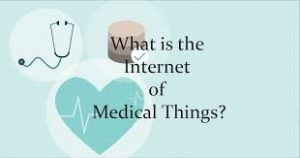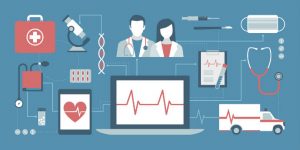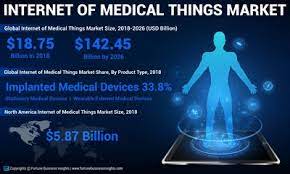Part 1: Turning to the Internet of Medical Things (IoMT)
 Like so many other businesses forced to find new ways to work during the COVID-19 pandemic, healthcare practices have been seeking new ways to expedite a digital transformation. Many physicians and patients are embracing virtual experiences. Welcome to the world of the Internet of Medical Things (IoMT).
Like so many other businesses forced to find new ways to work during the COVID-19 pandemic, healthcare practices have been seeking new ways to expedite a digital transformation. Many physicians and patients are embracing virtual experiences. Welcome to the world of the Internet of Medical Things (IoMT).
For physicians who are already aware of the advantages of going online for their reliable medical transcription services or encouraging the use of heart rate watches and other health technologies for their patients, connectivity is already part of your daily environment. Essentially, the IoMT is the collection of medical devices and applications that connect to healthcare IT systems through online computer networks. And more than ever, security and privacy are ongoing concerns.
In an unprecedented time, with virtual, arms-length (or more) relationships preferred, IoMT offers the potential to help a medical practice increase its reach. Devices that track vitals, monitor health and wellness markers, and help ensure compliance with smart pills and bottles notifying care givers and family members of missed doses or the need for medication refills can all improve patient outcomes and experiences – which can also keep costs down. With an aging population and an increasing shortage of healthcare providers, the healthcare system is already stressed. IoMT devices are a natural fit for telehealth solutions, increasing access by bypassing barriers to care.
Considering the tremendous amount of time spent supporting people with chronic or long-term conditions, connected technology has a great deal of potential to reduce the burden, as well as determine more precise treatment. IoMT brings care to the patient. They can remotely check-in with doctors, ask questions and perform simple tests on a connected device that shares the data in real-time.
Although there are some risks involved (more on that later), there is a lot to be said for transparency in a medical practice; as well as accurate recordkeeping.
Connected electronic health records (EHR) help streamline visits, avoiding the need for patients to consult with multiple physicians and start their health story from scratch – instead having their records easily shared from cloud storage. Patients may also take an active role in their health, with access to doctors’ notes after visits (another area where medical transcription services can help, especially with rapid transcription turnaround times).
Healthcare organizations are getting on board with IoMT. The global internet of medical things (IoMT) market is expected to swell to a US $158 billion valuation in 2022, up from $41 billion in 2017, which is a 287% increase in just five years. 
The challenges technology presents are many, including security and documentation. Medical practices will have to plan accordingly if, not when, adopting a more IoMT friendly strategy. Also, there is still a serious lack of standard within the medical community. While more and more devices come to market, there may be a limited ability to share information not only between devices, but also between patient and health-care providers with some of the wearables – at least with any consistency.
Maybe more important is the inherent cybersecurity risk. Readers of our pages know we take security seriously, whether during our medical transcription processes or through offering insight into how to address it in your practice. Lots of work remains to mitigate data breaches for IoMT adoption, which is a matter of patient safety when talking about connected devices like pacemakers, implanted defibrillators and insulin pumps, for example.
Most of us remember when in 2013, former United States Vice-President Dick Cheney revealed he had had his doctors disable his pacemaker’s wireless capabilities. He was concerned he could be assassinated through having the device hacked. And it was a storyline in an episode of “Homeland”.
Documentation is also key. Now, more than ever, may be the time to go to dictating your medical notes. With practices reopening and being even busier, you can save time by dictating, instead of handwriting or typing into an EMR. With the time you save by dictating, you may be surprised to find that it is also a cost-effective use of your time. And if you have space constraints, outsourcing your medical transcription is a good option for having fewer people in the office. And it could save you money.
Beyond privacy and security issues, there is also the front-end time and cost of implementation to consider. Although savings in time and cost eventually lean toward profit, it may not be for everyone – at least not until some of the bugs are worked out.
In Part II of this series, we will look at what it might take to put a strategy together, and some things to consider as you implement IoMT technology in your practise.
2Ascribe Inc. is a medical transcription services agency located in Toronto, Ontario Canada, providing medical transcription services to physicians, clinics and other healthcare providers across Canada. Our medical transcriptionists take pride in the quality of your transcribed documents. WEBscribe is our client interface portal for document management. 2Ascribe continues to implement and develop technology to assist and improve the transcription process for physicians and other healthcare providers, and recently introduced AUTOfax. AUTOfax works within WEBscribe to automatically send faxes to referring physicians when a document is signed off by the healthcare professional. As a service to our clients and the healthcare industry, 2Ascribe offers articles of interest to physicians and other healthcare professionals, medical transcriptionists and office staff, as well as of general interest. Additional articles may be found at http://www.2ascribe.com.

